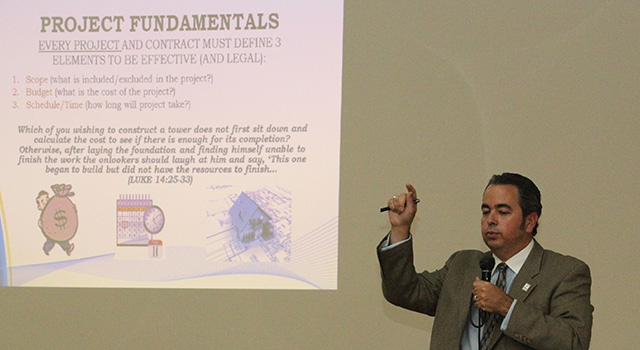By Cristina Cabrera Jarro -
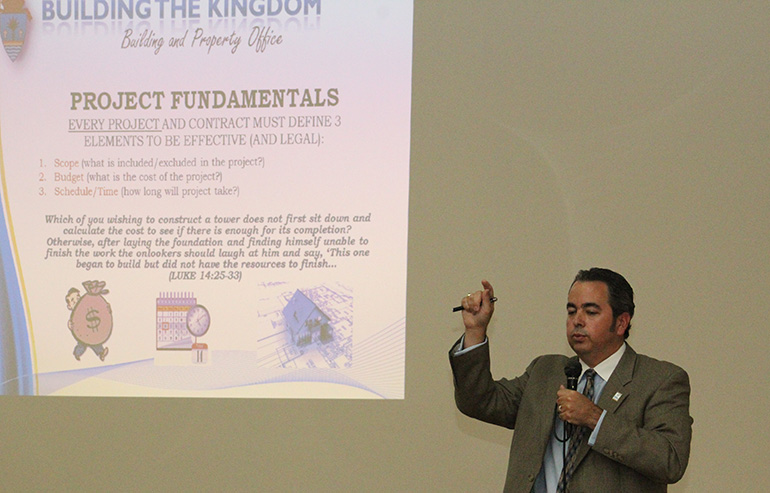
Photographer: CRISTINA CABRERA| FC
David Prada, senior director at the archdiocesan Building and Property Office, gives an Earth Day perspective during a talk on project fundamentals.
MIAMI | In the beginning, God created heaven and earth, and all that is in it. Then he created man and woman in his image, and gave them dominion over all living things. It was a slice of paradise handed to mankind on a silver platter.
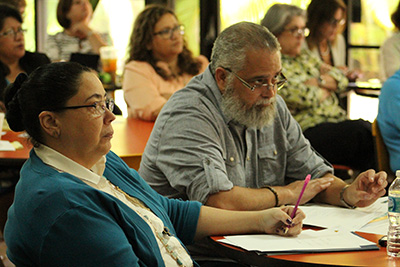
Photographer: CRISTINA CABRERA| FC
Rosa Frometa and Rafael Vazquez of St. Boniface Church in Pembroke Pines listen closely to details at the Earth Day Facility Management Training Seminar. With a green project of their own in mind, St. Boniface will be incorporating the help of their 81 ministries.
Mankind’s duty is to care for that creation, says David Prada, senior director of the archdiocese’s Building and Property Office.
“The story of creation demonstrates how in order to be authentic stewards of the earth we must balance three key concepts: stewardship, dominion, and ecology, both human and environmental,” Prada told a group gathered at the Pastoral Center on Earth Day, April 22.
The group consisted of over 40 people charged with maintaining the properties and spaces used for worship, education and gathering in archdiocesan parishes and schools. This was the first seminar of its kind, and the goal was to train them on best practices and procedures regarding building maintenance, repairs and insurance.
But caring for property also involves being good stewards of material resources, such as money and energy — a perfect link to Earth Day.
“The Catholic Church is getting involved in the environment,” Prada said. “It’s not only a political ideal. It’s a perspective geared towards the dignity of the human person.”
In other words: It’s not just about preserving the natural environment. It’s also about doing right by its human inhabitants.
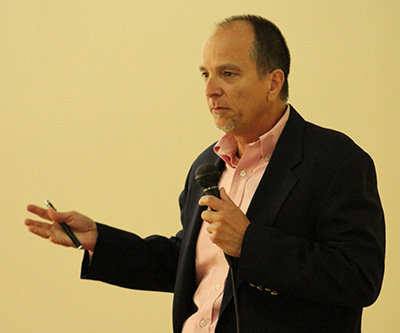
Photographer: CRISTINA CABRERA| FC
James Carballo, project manager at the archdiocesan Building and Property Office, discusses maintenance fundamentals at the Earth Day Facility Management Training Seminar. "Even the lightbulbs are important," Carballo said.
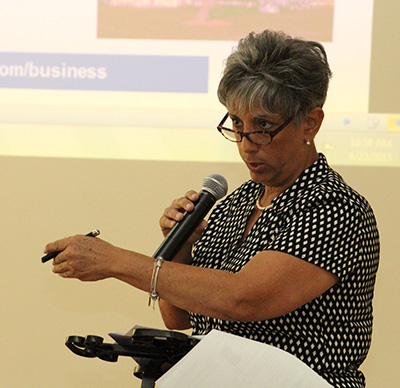
Photographer: CRISTINA CABRERA| FC
Idania Gonzalez of Florida Power and Light (FPL) discusses energy efficiency and management. "Parishes are using smart grid technology to monitor their energy use and I think it's a great idea," Gonzalez said.
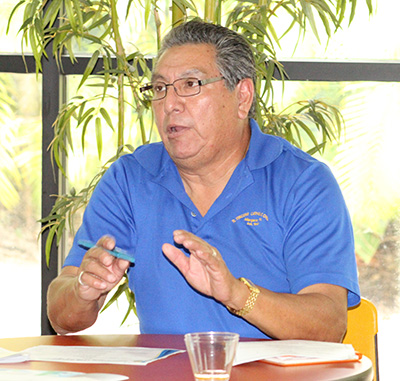
Photographer: CRISTINA CABRERA| FC
Raul Salinas of St. Vincent Church in Margate shares his maintenance concerns at the Earth Day Facility Training Seminar held by the Building and Property Office at the Archdiocese of Miami.
For the seminar and his presentation, Prada drew inspiration from the November 2014 “Reflection on Climate Change and Environmental Stewardship,” written by Archbishop Thomas Wenski as chair of the U.S. bishops’ Committee on Domestic Justice and Human Development.
The document stresses that it is against God’s plan “to see human beings as blight, as a force to be resisted rather than nurtured by our care of the environment.” Those who do so “have upended God’s plan and his purpose in placing us at the center of his earthly creative action.”
The document continues: “Our stewardship should always seek out the divine reflection that dwells in us. God calls us to a particular balance; any good steward endeavors to act, as closely as possible, as his or her master would act in his place, at least if the steward hopes to keep his job.”
In speaking about the environment, Archbishop Wenski and the U.S. bishops are following in the footsteps of other Catholic leaders. During his papacy, Pope Benedict XVI was known as the “green pope” for his support of environmental awareness and initiatives, as well as his move to install solar panels in the Vatican as a means of reducing Vatican City’s carbon footprint. Pope Francis is finalizing an encyclical on the environment, expected to be released later this year, to bring greater awareness to the issue worldwide.
“While the precise details of how climate change will affect the world are not known, the projections shared by scientists have been alarming,” Archbishop Wenski wrote in the document. “We can no longer ignore the visible signs that changes are occurring in our environment that will affect all life, especially human life.”
So what initiatives are being undertaken by archdiocesan parishes and schools to preserve and nourish the environment?
For starters, Prada is a LEED-certified architect, which stands for Leadership in Energy and Environmental Design. He is applying the U.S. Green Building Council (USGBC) rating system to the design, construction and operation of archdiocesan buildings. The system takes into consideration sustainable sites, water efficiency, energy performance, renewable energy sources, waste management, recycling and use of recycled materials, and indoor environmental quality, among other things.
New parishes, like Our Lady of Guadalupe Church currently under construction in Doral, will be built with an environmental conscience, not only in terms of materials but in terms of how used materials are disposed of.
“As of March 2015, our builder, MCM Construction, has confirmed 88 percent of the waste generated by the (Guadalupe) project has been diverted from landfills; and their current goal is 75 percent,” Prada said.
St. Boniface Church in Pembroke Pines has invited members of each of its ministries to join in the environmental effort by getting their hands dirty.
“We’re working on a never-ending project,” said Rosa Frometa, maintenance coordinator at St. Boniface. “We want to beautify the grounds because it adds to the appeal. With 81 ministries, each one will be responsible for gardening a portion of the grounds.”
With some archdiocesan parishes and schools reaching beyond their 50-year anniversaries, maintenance also is an essential element, not just for preservation but also for safety.
“Maintenance is tough, but you see how important it is,” said Donna Murphy, maintenance supervisor at Mary Help of Christians Church and School in Parkland.
“You need to stay on top of the maintenance and appearance of a property,” stressed James Carballo, project manager at the Building and Property Office, in his talk to seminar participants. “Even the lightbulbs are important. You’ll notice things like that and say, ‘I need to take care of it.’”
Energy experts from Florida Power and Light and insurance experts from Gallagher-Bassett, the archdiocese’s claims administrator, also spoke to the parish and school representatives.
The day served as a reminder that the care and maintenance of parishes and schools depends on the Catholic community, but the preservation of earth depends on all of mankind.
As Prada put it at the end of the day: “We’ve come a long way: from Genesis to LEDs.”
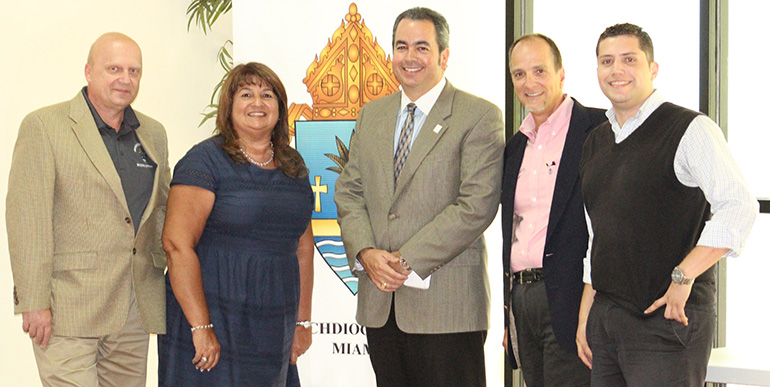
Photographer: CRISTINA CABRERA| FC
The Building and Property Office team that helps build and maintain archdiocesan churches and schools consists of, from left: Pawel Kobrzynski, assistant building and project manager, Janet Rancaño, office coordinator, David Prada, senior director, James Carballo, project manager, and Alfonso Balmaceda, administrative assistant and data clerk.
